The College must increase student enrollment, value accessibility over prestigious exclusivity
November 2, 2022

What is the ultimate objective of the College?
Higher education should aim to provide the best possible education to the greatest number of students. Sadly, at nearly all elite private institutions, this is far from reality. While the College strives to offer its students the highest-quality education, it limits this benefit to a small minority. In 2000, the College had an undergraduate population of 2,020 students. That number has grown to just 2,121 as of the 2021–22 academic year. This mere 5-percent increase in population pales in comparison to the roughly 200-percent increase in our endowment — from $1.4 billion to $4.2 billion — over the same time period (unadjusted for inflation).
Why hasn’t the College increased its enrollment? We assume that increasing our student population would be too costly an endeavor to maintain a high-quality education. We would need to expand our faculty, dining, and housing, all three of which the College has had issues fulfilling.
However, our endowment reached $4.2 billion last year. To put this into perspective, the GDP of Sierra Leone is $4.2 billion. More astonishingly, this staggering endowment translates to nearly $2 million per student. Compare this to other universities: On a per-student basis, our endowment easily surpasses those of top universities: Dartmouth ($1.25 million), the University of Pennsylvania ($875,000), the University of Chicago ($596,000), and Columbia University ($425,000). All of these institutions register student populations vastly higher than our own, yet they provide their students with an high-quality education. With an endowment significantly higher than these world-class institutions, we are more than capable of expanding our population.
Unfortunately, this year’s market dynamics did not wish to coincide perfectly with my opinion. In 2022, the endowment has lost significant value. While this may be grounds to put off present growth, it should not nullify the school’s long-term expansion. The history of our endowment has shown its propensity to persevere through financial volatility and downturn.
I am not proposing an immediate and substantial increase in our population. The pinnacle example we should follow is the University of California, Berkeley’s — even with legal challenges and a daunting lack of physical space, Berkeley manages to increase its enrollment by 2 percent most years. If we managed to attain even 1 percent of enrollment growth per year, this would result in over 100 additional students graduating each year. The College has made commendable improvements in diversity and equity over the past couple of decades. We have given marginalized students access to the school, while also pursuing initiatives to make the campus more inclusive. Since 2000, students of color and international students at Williams have gone from making up 28 percent to 48 percent of the student population. In this time period, the average financial aid package increased from $22,618 to $63,516. These notable developments have advanced the aim of our school: to make our education more widely accessible. If we value the equitable inclusion of students from marginalized and underrepresented backgrounds, why don’t we value including more students altogether?
The true motivation for keeping enrollment stagnant may be the College’s commitment to its brand name. The Ivy League, the “Ivy-Plus” schools (MIT, Stanford, etc.), and the “Little Ivies” (NESCAC schools) provide their students the highest quality of education. However, a primary appeal of these schools is the prestige and status equated to their valuable brands. Today, the purpose of a diploma from a respected university is not the quality of education behind it, but rather the brand name associated with that education. Receiving a college education has become a luxury good; it is our way to demonstrate social status and value to others. What is better able to flaunt status in today’s society than an Hermès purse or a Canada Goose sweater? A diploma from an elite university. What two words do you have at the top of your Instagram bio or LinkedIn page? Williams College.
This desire for reputation and exclusivity, associated with a luxury brand, drives our idolatry of a continually decreasing acceptance rate. There is nothing more titillating to the ego of an alum than seeing their college’s acceptance rate creep lower and lower into the single digits. When our institution becomes more exclusive to the public, our perception of personal value increases.
Increasing our enrollment would transform the College’s purpose, away from our captivation with exclusion, towards what we truly value. It would be one of the most equitable and noble initiatives the College should embrace.
Dylan Mealey ’26 is from Los Angeles, Calif.








